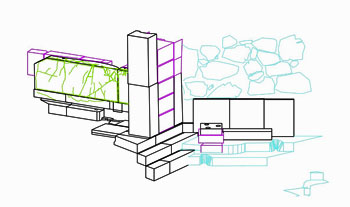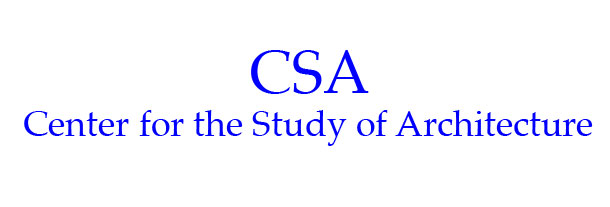

Information Dissemination:
• The CSA Newsletter
Now in its twenty-third year and with all issues available on the Web, The CSA Newsletter includes articles about projects, specific technologies, and technology trends of interest. (A limited subject index is available.
• Technology Information
The CSA Technology Information web page is a gateway to materials designed to aid archaeologists and architectural historians when considering computer technologies, especially CAD and database management systems.
•
Many documents were created for CSA's digital archiving efforts. Those archival efforts have all been discontinued, but the documents concerning archival needs and procedures remain valuable. They may be found via the archives page.
Projects:
• The CSA Propylaea Project.
This was a cooperative project to create a single digital resource of information about the Propylaea. The project has been terminated, and all materials produced may be found at the web site.
• The Older Propylon Project. This is a concluded research project of CSA Director Harrison Eiteljorg, II. The results of this project have been published; archival materials, including CAD models, may be accessed through the Archaeological Research Institute at Arizona State University.
• Lantern Slides of Classical Antiquity
This project was a joint CSA/Bryn Mawr College project. Lantern slides from the College collection were digitized and made available on the Web, and high-resolution images were archived for future use. This project is now maintained by Bryn Mawr College.
• Pompeii Forum Project CSA participates in this on-going project, Directed by Prof. John J. Dobbins (University of Virginia), to study the Forum of ancient Pompeii. A computer-aided design model is being constructed of the forum.
• Bryn Mawr Electronic Resources Review (BMERR). BMERR was an online journal for reviews of electronic resources concerning the ancient world. Bryn Mawr Classical Review (BMCR) is now publishing reviews of electronic resources, and BMERR has discontinued its separate existence. Reviews published 1998-2000 are now available through the BMCR web site (http://bmcr.brynmawr.edu/) and they are available via the BMERR page there.
•
Second Edition, December, 2008
This second edition contains one entirely new chapter concerning the digitizing of data from long-running and/or completed projects. The first edition was focused solely on "born digital" data, yet it should have been clear that many digitizing projects for archaeological data are concerned with data already collected in non-digital forms, requiring digitizing to be approached from a very different perspective. This edition also has been proofread yet again. As a result, it became all too clear that a number of typos and other small errors had been missed in the final proofreading of the first edtion. That number was large enough that it seems pointless to hope all such errors have been found and eliminated. We can at least hope the number has been reduced significantly. The preparation of the second edition also turned up errors in some SELECT statements in the database management chapter. Those statements should now be correct. Other changes are neither critical to meaning nor numerous. |
Archaeological Computing is intended to provide an introduction to the use of digital technologies for archaeologists. The first two chapters of the book include discussions of a variety of general computing issues, with special emphases on some matters of more importance to scholars, especially archaeologists, than typical computer users. The three following chapters are focused on the three critical data-recording technologies for archaeological projects -- database management, GIS, and CAD -- in that sequence. The authors explore the capabilities of those three software types, and much of the discussion centers on organizing data effectively so that the capabilities of the software -- and the utility of the software for archaeologists -- can be maximized. In the sixth chapter other digital technologies; including digital images, audio, and various kinds of moving images; are discussed in terms of the problems raised by their being digital as opposed to film- or paper-based. The new seventh chapter contains a lengthy but at times frustratingly general and theoretcial discussion of the processes required to digitize data already gathered but not in digital form. The generalities and theoretical approach are required by the diversity of projects for which digitizing paper-based data may be desirable. A lengthy discussion of digital data protection and preservation follows in the eighth chapter. The ninth and final chapter provides a wrap-up.
Abbreviated Table of Contents:
- Introduction - Why?
- Chapter I - Some Basics
- Chapter II - Computing and Computers
- Chapter III - Recording Data about Objects, Loci, Trenches, Features, . . .
from Archaeological Projects: Databases and Database Management Systems - Chapter IV - Combining Maps and Data: Geographic Information Systems
- Chapter V - Modeling Objects, Loci, Trenches, Features, . . .
from Archaeological Projects: Computer-Aided Design Software - Chapter VI - Miscellany: Digital Images, Audio Recordings, Videos, and Text
- Chapter VII - Digitizing Data from an Extant Project
- Chapter VIII - Protecting and Preserving the Archaeological Record
- Chapter IX - Conclusion
The second edition of Archaeological Computing is available here, at no cost, as a PDF download. Publishing in this way means, among other things, that the book can be changed by the authors with relatively little trouble, as it now has been with this second edition. The authors, of course, think the book is all but perfect as it stands; so they are counting on the readers to suggest the ways that change is needed. We need to know if there are terms in need of definitions, terms in need of better definitions, fuller or more coherent explanations needed for specific topics, topics in need of coverage, more illustrations needed, desirable changes in formatting, or . . . . We are counting on you, the reader, to let us know and to help make this book better and better over time. To do that, please email Mr. Eiteljorg or Mr. Limp (see the CSA email contacts page for the email addresses). It must be noted that the number of such contacts after the posting of the first edition was vanishingly small; please do not keep your criticisms to yourselves. We can only fix the problems about which we are made aware.
This page will contain information about the version of the book currently available so that any user will know its date and revision history. The current version is the second. The original version was completed in March of 2007 and made available in April, 2007. A trivial revision to correct a format error was made on that same day. This second edition is being posted on 18 December 2008.
We hope to use the web site to assist readers in other ways, two of them being carried out already. You will find a page concerned with table joins and SQL queries here. In addition, there is a unified glossary here to augment the glossary in the book, which is spread out over several chapters, each with a glossary for its own subject matter. (The glossary has been updated to reflect the second edition chapter glossaries.) Other, similar pages will be added to the site, as needed, in response to readers' needs. Note, though, that we cannot predict those needs and must hear from the readers to know what things to try to add - and in what way(s) to add them. We have considered discussion groups of several kinds, but we decided to plan nothing in advance and to wait for the readers to tell us through their comments what things might be useful. Your feedback is therefore crucial.
There are two versions of the book, one for standard printing on one side of the paper only and the other for duplex printing. The text is the same; the only differences are the arrangements of margins and the orientations of pages that will be on the left in the duplex version, making the two versions equally useful on screen. Either version should have margins wide enough to permit using either a loose-leaf binder or a spring binder. Layout was based on North-American-sized 8.5 x 11 in. paper, but the margins should permit printing on A4 paper as well.
- You may download the PDF as often as you like, and you may use the file on screen, by making a printed version, or both.
- Your own use of the PDF file is limited only in that you may not modify it. However, you may not give or sell the file to anyone else.
- You may print as many copies from the PDF as you wish, but only for your own use. No copies may be printed for others, regardless of whether or not a fee is charged by you.
- Nothing in the foregoing should be seen as limiting your right to refer to, quote, or cite the work in standard academic fashion.
These conditions are intended simply to make certain that any user knows the date and currency of the version of the document at hand. For instance, the existence of the second edition now makes the first edition obsolete, but someone obtaining the first edition from an intermediary might not realize that the first edition had been superseded. Of course, we want to be sure that alterations that might alter the intent of the authors are not made so that the authors may be responsible only for their own words.
To continue to the download page, please click here.
We hope you find this useful, and we look forward to knowing your reactions to the book. (Should you have some reason to want to first edition of the book, please contact Harrison Eiteljorg at CSA for instructions to download it. It remains available as a downloadable PDF file via the web site.)
- Title: Archaeological Computing
- Author: Harrison Eiteljorg, II and the staff of CSA, Box 60, Bryn Mawr, PA 19010 (email: user-name nicke at (@) domain-name csanet.org; tel.: 484-612-5862)
- File name: archcompindex.html
- Revision history: This document was originally posted on 12 April 2007. The current version is the second one and the first major change. Additional changes are expected to occur regularly; there will be no archiving of past versions, absent a specific need to do so. Revised 18 December 2008. Updated (only for slight changes in appearance of header) 18 March 2010 and again in August of 2010.
- Internet access: This document is maintained at csanet.org by the Center for the Study of Architecture and Harrison Eiteljorg, II. Note that there may be changes in computer addresses that are beyond the control of CSA.
- Long-term availability: This document or its successors will be maintained for electronic access indefinitely. Prior versions will not be archived.
- Citation permissions and copyright information: This document is copyrighted by CSA. Citations should include the date the document was accessed.